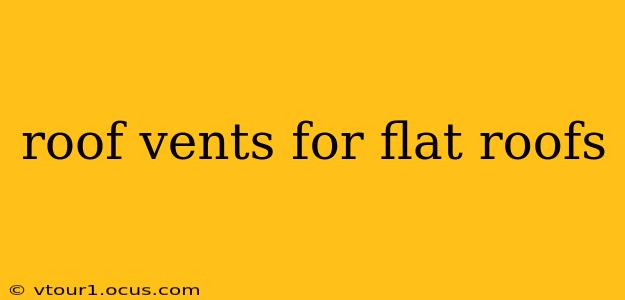Flat roofs, while aesthetically pleasing and offering efficient use of space, present unique challenges when it comes to ventilation. Proper ventilation is crucial for preventing moisture buildup, extending the lifespan of your roof, and maintaining a comfortable indoor environment. This guide explores the various types of roof vents for flat roofs, their functionalities, and how to choose the right one for your needs.
What are the Benefits of Roof Vents for Flat Roofs?
Adequate ventilation in a flat roof system is paramount. Without it, trapped moisture can lead to a host of problems, including:
- Mold and mildew growth: Damp conditions create the perfect breeding ground for mold and mildew, compromising indoor air quality and potentially causing health issues.
- Structural damage: Persistent moisture can weaken the structural integrity of your roof decking and insulation, leading to costly repairs or even roof collapse.
- Shorter roof lifespan: Moisture damage significantly reduces the lifespan of your roofing materials, necessitating premature replacements.
- Ice dams in colder climates: In freezing temperatures, trapped moisture can freeze and form ice dams, leading to leaks and further damage.
What Types of Roof Vents are Suitable for Flat Roofs?
Several types of vents effectively address ventilation needs in flat roof systems:
1. Low-Profile Vents:
These vents sit flush or nearly flush with the roof surface, minimizing disruption to the overall aesthetic. They are often designed with a low-profile design that won't impede the look of your roof. They are effective at providing passive ventilation and are often a good choice for those who want to retain the clean lines of a flat roof.
2. Curb Vents:
Curb vents are raised above the roof surface, creating a slight protrusion. This raised design enhances airflow and is frequently used in conjunction with mechanical exhaust systems. They are very commonly used, especially with larger flat roofs.
3. Solar Vents:
These vents utilize solar energy to power a small fan, actively drawing out hot, moist air. They're particularly effective in warmer climates and can significantly improve ventilation efficiency compared to passive systems. Solar powered vents are a great environmentally friendly choice for increased ventilation.
4. Ridge Vents (for slightly sloped flat roofs):
While not strictly applicable to perfectly flat roofs, some flat roofs have a very slight slope. In such cases, ridge vents can be incorporated along the highest point to allow for natural airflow. Even a very slight slope can greatly improve venting effectiveness.
5. Exhaust Fans:
Mechanical exhaust fans are often installed to actively remove moist air from attics or crawl spaces beneath flat roofs. While not a vent in the traditional sense, they play a crucial role in overall ventilation strategy. These fans are particularly helpful in areas with high humidity or where passive ventilation is insufficient.
How Many Vents Do I Need for My Flat Roof?
The number of vents needed depends on several factors, including:
- Roof size and area: Larger roofs require more vents to ensure adequate airflow.
- Climate: Hot and humid climates necessitate more aggressive ventilation than drier climates.
- Insulation type and level: Highly insulated roofs might require fewer vents compared to those with less insulation.
- Type of roofing material: Certain roofing materials are more susceptible to moisture damage and may benefit from increased ventilation.
It's recommended to consult with a roofing professional to determine the appropriate number and placement of vents for your specific situation. They can perform a detailed assessment and provide tailored recommendations to ensure optimal ventilation and long-term roof health.
What is the Best Placement for Roof Vents on a Flat Roof?
Optimal vent placement aims to create effective airflow patterns. Ideally, intake vents should be located lower on the roof and exhaust vents higher up, allowing for natural convection. However, this can be complicated by building design features and other constraints. Proper placement ensures maximum air circulation and ventilation efficiency. Again, consult a professional for site-specific recommendations.
How Much Does it Cost to Install Roof Vents on a Flat Roof?
The cost of installing roof vents varies greatly depending on the type of vent chosen, the size of your roof, labor costs in your area, and the complexity of the installation. It is always best to get quotes from multiple roofing contractors to compare pricing and services before commencing any work.
Can I Install Roof Vents Myself?
While some simpler vent installations might be manageable for DIY enthusiasts with roofing experience, more complex installations, particularly those involving mechanical systems or curb vents, are best left to professionals. Incorrect installation can compromise the effectiveness of the vents and even lead to further damage to your roof. Safety should always be the top priority, and professional installation offers peace of mind.
This comprehensive guide provides a thorough overview of roof vents for flat roofs. Remember, proper ventilation is critical for maintaining the integrity and longevity of your flat roof. Consult a qualified roofing professional for personalized advice and installation services to ensure optimal results.
